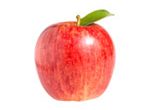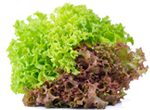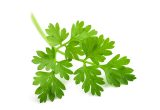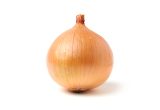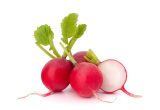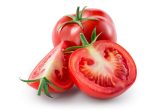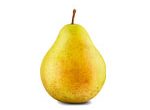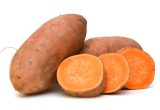Fennel

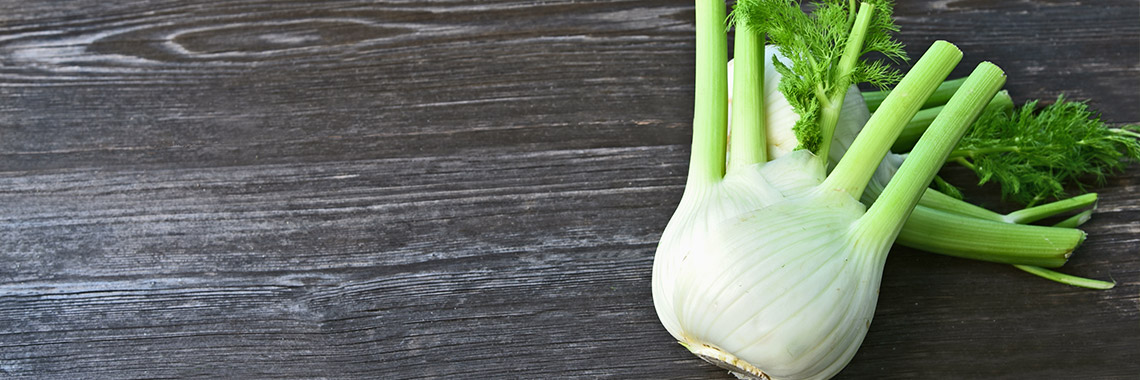
Description
- Fennel (Foeniculum vulgare) belongs to the Apiaceae family.
- It is well known in the Mediterranean region, but also occurs in temperate regions, both in the wild and in cultivation (Ghanem, 2012).
PHYSICAL AND ORGANOLEPTIC CHARACTERISTICS
- Fennel is a perennial herbaceous plant and is branched with soft, feathery, bright green foliage (Badgujar, 2014).
- It is known for its aniseed flavour due in particular to the essential oils it contains, of which mainly anethol (Badgujar, 2014; Saxena, 2018).
- Fennel essential oil also contains volatile compounds such as α-pinene, camphene, β-pinene, myrcene, cymene, γ-terpinene, estragole and geranyl acetate (Saxena, 2018).
- Phenolic compounds are an important constituent of fruit quality because of their contribution to the taste, colour and nutritional properties of the fruit. The polyphenols analysed in the fruit of this plant include mainly: apigenin, quercetin, rosmarinic acid, chlorogenic acid, p-coumaric acid, ferulic acid-7-o-glucoside, 3,4-dihydroxy-phenetylalcohol-6-O-caffeoyl-β-D-glucopyranoside and 3′,8′-binaringenin (Badgujar, 2014 Ghanem, 2012).
COMPOSITION CHARACTERISTICS (excluding macronutrients, vitamins and minerals)
- Fennel has antioxidant, anti-inflammatory, anti-allergic, antispasmodic and hepato-protective properties (Javed, 2020).
- It is said to be effective in reducing disorders of the gastrointestinal tract, increasing the production of breast milk and to have estrogenic activity. Fennel is also said to improve memory and promote muscle relaxation (Lee, 2018).
- Fennel, due to its content of phytoestrogens, is reported to be effective in reducing the effects of menopause such as skin ageing, osteoporosis, vaginal atrophy, sleep disorders, and cognitive impairment, etc., without serious side effects (Rahimikian, 2017).
- It is also believed to have antidepressant and anti-anxiety properties in postmenopausal women (Ghazanfarpour, 2018).
RAW
The following values are approximate and depend on variety, season, ripeness, cultivation conditions, etc.
Raw fennel is low in energy* as it provides an average of 21.80 calories (kcal) per 100 g, i.e. 90.90 kJ.
One fennel weighs on average between 200 and 300 g, which represents an energy intake of 43.60 to 65.40 kcal.
COMPOSITION TABLES
For each nutrient, the tables provide information on the content, the minimum and maximum values, as well as the percentage of the Dietary Reference Values (DRVs) for 100 g net of raw fennel.
*Regulation (EC) No 1924/2006 of the European Parliament and of the Council of 20 December 2006 on nutrition and health claims made on foods.
MACRONUTRIENTS
| Constituent (g) | Average content |
Min-Max per 100g |
DRV% |
|---|---|---|---|
| Water | 92,9 | 90,20 - 95,90 | - |
| Fibers | 2,60 | 1,60 - 3,10 | - |
| Carbohydrates | 2,63 | 1,60 - 3 | 1,01 |
| Sugars | 2,20 | 1,20 - 3,93 | 2,44 |
| Lipids | < 0,50 | 0 - NC | - |
| Saturated fat | < 0,01 | NC - 0,10 | - |
| Protein | 1 | NC - 1,25 | 2 |
| Constituent (g) | Amount | Min-Max | DRV% |
|---|---|---|---|
| Water | Ciqual 2020 (valeur issue des analyses Ciqual-Aprifel 2017) | - | - |
| Fibers | Ciqual 2020 (valeur issue des analyses Ciqual-Aprifel 2017) | - | - |
| Carbohydrates | Ciqual 2020 | - | Règlement (UE) N°1169/2011 du parlement Européen et du conseil du 25 octobre 2011 |
| Sugars | Ciqual 2020 (valeur issue des analyses Ciqual-Aprifel 2017) | - | Règlement (UE) N°1169/2011 du parlement Européen et du conseil du 25 octobre 2011 |
| Lipids | Ciqual 2020 (valeur issue des analyses Ciqual-Aprifel 2017) | - | Règlement (UE) N°1169/2011 du parlement Européen et du conseil du 25 octobre 2011 |
| Saturated fat | Ciqual 2020 (valeur issue des analyses Ciqual-Aprifel 2017) | - | Règlement (UE) N°1169/2011 du parlement Européen et du conseil du 25 octobre 2011 |
| Protein | Ciqual 2020 (valeur issue des analyses Ciqual-Aprifel 2017) | - | Règlement (UE) N°1169/2011 du parlement Européen et du conseil du 25 octobre 2011 |
Zoom on carbohydrates
- The carbohydrate content of raw fennel (2.63 g per 100 g) is lower than the average amount in raw vegetables (4.45 g per 100 g).
- These are mainly glucose (1.20 g per 100 g) and fructose (1 g per 100 g).
- Raw fennel is low in sugar* (2.20 g per 100 g) as it contains no more than 5 g per 100 g.
Zoom on fibres
- The fibre content of fennel (2.60 g per 100 g) is higher than the average amount in raw vegetables (2.43 g per 100 g).
Zoom on proteins
- The protein content of fennel (1 g per 100 g) is lower than the average amount found in raw vegetables (1.87 g per 100 g).
Zoom on lipids
- Raw fennel is fat-free* as it contains less than 0.5 g per 100 g.
*Regulation (EC) No 1924/2006 of the European Parliament and of the Council of 20 December 2006 on nutrition and health claims made on foods.
MINERALS AND TRACE ELEMENTS
| Constituent | Average content |
Min-Max per 100g |
DRV% |
|---|---|---|---|
| Calcium (mg) | 37 | 8,46 - 56 | 4,63 |
| Chloride (mg) | 78,6 | - | 9,83 |
| Copper (mg) | 0,08 | 0,066 - NC | 8 |
| Iron (mg) | 0,20 | NC - 0,73 | 1,43 |
| Iodine (µg) | < 20 | - | - |
| Magnesium (mg) | 11 | 8,30 - 17 | 2,93 |
| Manganese (mg) | 0,10 | NC - 0,19 | 5 |
| Phosphorus (mg) | 28 | 27,10 - 51,40 | 4 |
| Potassium (mg) | 320 | NC - 470 | 16 |
| Selenium (µg) | < 20 | - | - |
| Sodium (mg) | 22 | 12 - 52 | - |
| Zinc (mg) | 0,19 | 0,18 - 0,28 | 1,90 |
| Constituent | Amount | Min-Max | DRV% |
|---|---|---|---|
| Calcium (mg) | Ciqual 2020 (valeur issue des analyses Ciqual-Aprifel 2017) | - | Règlement (UE) N°1169/2011 du parlement Européen et du conseil du 25 octobre 2011 |
| Chloride (mg) | Ciqual 2020 (valeur issue des analyses Ciqual-Aprifel 2017) | - | Règlement (UE) N°1169/2011 du parlement Européen et du conseil du 25 octobre 2011 |
| Copper (mg) | Ciqual 2020 (valeur issue des analyses Ciqual-Aprifel 2017) | - | Règlement (UE) N°1169/2011 du parlement Européen et du conseil du 25 octobre 2011 |
| Iron (mg) | Ciqual 2020 (valeur issue des analyses Ciqual-Aprifel 2017) | - | Règlement (UE) N°1169/2011 du parlement Européen et du conseil du 25 octobre 2011 |
| Iodine (µg) | Ciqual 2020 (valeur issue des analyses Ciqual-Aprifel 2017) | - | Règlement (UE) N°1169/2011 du parlement Européen et du conseil du 25 octobre 2011 |
| Magnesium (mg) | Ciqual 2020 (valeur issue des analyses Ciqual-Aprifel 2017) | - | Règlement (UE) N°1169/2011 du parlement Européen et du conseil du 25 octobre 2011 |
| Manganese (mg) | Ciqual 2020 (valeur issue des analyses Ciqual-Aprifel 2017) | - | Règlement (UE) N°1169/2011 du parlement Européen et du conseil du 25 octobre 2011 |
| Phosphorus (mg) | Ciqual 2020 (valeur issue des analyses Ciqual-Aprifel 2017) | - | Règlement (UE) N°1169/2011 du parlement Européen et du conseil du 25 octobre 2011 |
| Potassium (mg) | Ciqual 2020 (valeur issue des analyses Ciqual-Aprifel 2017) | - | Règlement (UE) N°1169/2011 du parlement Européen et du conseil du 25 octobre 2011 |
| Selenium (µg) | Ciqual 2020 (valeur issue des analyses Ciqual-Aprifel 2017) | - | Règlement (UE) N°1169/2011 du parlement Européen et du conseil du 25 octobre 2011 |
| Sodium (mg) | Ciqual 2020 (valeur issue des analyses Ciqual-Aprifel 2017) | - | - |
| Zinc (mg) | Ciqual 2020 (valeur issue des analyses Ciqual-Aprifel 2017) | - | Règlement (UE) N°1169/2011 du parlement Européen et du conseil du 25 octobre 2011 |
Zoom on minerals and trace elements
- Raw fennel is a source of potassium as it provides the equivalent of 16% of DRVs, i.e. 320 mg per 100 g.
- The trace element best represented in raw fennel is chloride. It is present in an amount equivalent to 9.83% of DRVs, i.e. 78.60 mg per 100 g.
- The other minerals and trace elements are present in quantities representing less than 9% of DRVs.
VITAMINS
| Constituent | Average content |
Min-Max per 100g |
DRV% |
|---|---|---|---|
| Provitamin A Beta-carotene (µg) | 8,01 | NC - 578 | - |
| Vitamin A equivalent (µg) | 1,34 | NC - 96,33 | 0,17 |
| Vitamin B1 (mg) | < 0,015 | 0,01 - 0,033 | - |
| Vitamin B2 (mg) | < 0,01 | NC - 0,11 | - |
| Vitamin B3 (mg) | < 0,10 | NC - 0,64 | - |
| Vitamin B5 (mg) | 0,22 | NC - 0,23 | 3,67 |
| Vitamin B6 (mg) | 0,05 | 0,036 - 0,081 | 3,57 |
| Vitamin B9 (µg) | 19,60 | NC - 34 | 9,80 |
| Vitamin C (mg) | 2,57 | NC - 12 | 3,21 |
| Vitamin E (mg) | < 0,08 | NC - 0,58 | - |
| Vitamin K1 (µg) | 62,80 | - | 83,73 |
| Constituent | Amount | Min-Max | DRV% |
|---|---|---|---|
| Provitamin A Beta-carotene (µg) | Ciqual 2020 (valeur issue des analyses Ciqual-Aprifel 2017) | - | - |
| Vitamin A equivalent (µg) | Calcul à partir de la valeur Provitamine A Béta-carotène* | - | Règlement (UE) N°1169/2011 du parlement Européen et du conseil du 25 octobre 2011 |
| Vitamin B1 (mg) | Ciqual 2020 (valeur issue des analyses Ciqual-Aprifel 2017) | - | Règlement (UE) N°1169/2011 du parlement Européen et du conseil du 25 octobre 2011 |
| Vitamin B2 (mg) | Ciqual 2020 (valeur issue des analyses Ciqual-Aprifel 2017) | - | Règlement (UE) N°1169/2011 du parlement Européen et du conseil du 25 octobre 2011 |
| Vitamin B3 (mg) | Ciqual 2020 (valeur issue des analyses Ciqual-Aprifel 2017) | - | Règlement (UE) N°1169/2011 du parlement Européen et du conseil du 25 octobre 2011 |
| Vitamin B5 (mg) | Ciqual 2020 (valeur issue des analyses Ciqual-Aprifel 2017) | - | Règlement (UE) N°1169/2011 du parlement Européen et du conseil du 25 octobre 2011 |
| Vitamin B6 (mg) | Ciqual 2020 (valeur issue des analyses Ciqual-Aprifel 2017) | - | Règlement (UE) N°1169/2011 du parlement Européen et du conseil du 25 octobre 2011 |
| Vitamin B9 (µg) | Ciqual 2020 (valeur issue des analyses Ciqual-Aprifel 2017) | - | Règlement (UE) N°1169/2011 du parlement Européen et du conseil du 25 octobre 2011 |
| Vitamin C (mg) | Ciqual 2020 (valeur issue des analyses Ciqual-Aprifel 2017) | - | Règlement (UE) N°1169/2011 du parlement Européen et du conseil du 25 octobre 2011 |
| Vitamin E (mg) | Ciqual 2020 | - | Règlement (UE) N°1169/2011 du parlement Européen et du conseil du 25 octobre 2011 |
| Vitamin K1 (µg) | Ciqual 2020 (valeur issue des analyses Ciqual-Aprifel 2017) | - | Règlement (UE) N°1169/2011 du parlement Européen et du conseil du 25 octobre 2011 |
Zoom on vitamins
- Raw fennel is high in vitamin K1 as it provides the equivalent of 83.73% of DRVs, i.e. 62.80 µg per 100 g.
- The vitamin best represented after vitamin K1 in raw fennel is vitamin B9. It is present in a quantity equivalent to 9.80% of DRVs, i.e. 19.60 µg per 100 g.
- The other vitamins represent less than 4% of DRVs.
* Calculation made: Beta-carotene / 6 + retinol
POLYPHENOLS
| Constituent (mg) | Average content |
Min-Max per 100mg |
|---|---|---|
| Lignanes (mg) | 0,06 | - |
| Total polyphenols | 0,06 | - |
| Constituent (mg) | Amount | Min-Max |
|---|---|---|
| Lignanes | Phenol explorer, version 3.6 Méthode utilisée : Chromatographie après hydrolyse | - |
| Total polyphenols | Phenol explorer, version 3.6 Méthode utilisée : Chromatographie après hydrolyse | - |
Zoom on polyphenols
- Polyphenols are substances with an antioxidant effect.
The polyphenols in raw fennel are mainly lignans.
STEWED
Stewed fennel is low in energy* as it provides an average of 13.70 calories (kcal) per 100 g, i.e. 57.10 kJ. According to the Ciqual 2020 table, stewed fennel is the lowest calorie vegetable.
One fennel weighs on average between 200 and 300 g, which represents an energy intake of 27.40 to 41.10 kcal.
COMPOSITION TABLES
For each nutrient, the tables provide information on the content, the minimum and maximum values, as well as the percentage of the Dietary Reference Values (DRVs) for 100 g net of stewed fennel.
*Regulation (EC) No 1924/2006 of the European Parliament and of the Council of 20 December 2006 on nutrition and health claims made on foods.
MACRONUTRIENTS
| Constituent (g) | Average content |
Min-Max per 100g |
DRV% |
|---|---|---|---|
| Water | 95,1 | - | - |
| Fibers | 1,80 | - | - |
| Carbohydrates | 1,94 | - | 0,75 |
| Sugars | 1,30 | - | 1,44 |
| Lipids | < 0,30 | - | - |
| Saturated fat | < 0,01 | - | - |
| Protein | < 0,50 | - | - |
| Constituent (g) | Amount | Min-Max | DRV% |
|---|---|---|---|
| Water | Ciqual 2020 (valeur issue des analyses Ciqual-Aprifel 2018) | - | - |
| Fibers | Ciqual 2020 (valeur issue des analyses Ciqual-Aprifel 2018) | - | - |
| Carbohydrates | Ciqual 2020 | - | Règlement (UE) N°1169/2011 du parlement Européen et du conseil du 25 octobre 2011 |
| Sugars | Ciqual 2020 (valeur issue des analyses Ciqual-Aprifel 2018) | - | Règlement (UE) N°1169/2011 du parlement Européen et du conseil du 25 octobre 2011 |
| Lipids | Ciqual 2020 (valeur issue des analyses Ciqual-Aprifel 2018) | - | Règlement (UE) N°1169/2011 du parlement Européen et du conseil du 25 octobre 2011 |
| Saturated fat | Ciqual 2020 (valeur issue des analyses Ciqual-Aprifel 2018) | - | Règlement (UE) N°1169/2011 du parlement Européen et du conseil du 25 octobre 2011 |
| Protein | Ciqual 2020 (valeur issue des analyses Ciqual-Aprifel 2018) | - | Règlement (UE) N°1169/2011 du parlement Européen et du conseil du 25 octobre 2011 |
Zoom on carbohydrates
- The carbohydrate content of stewed fennel (1.94 g per 100 g) is lower than the average amount found in cooked vegetables (4.85 g per 100 g)
- They are mainly in the form of glucose (0.80 g per 100 g) and fructose (0.50 g per 100 g).
- Stewed fennel is low in sugar* (1.30 g per 100 g) as it contains no more than 5 g per 100 g.
Zoom on fibres
- Its fibre content (1.80 g per 100 g) is lower than the average amount found in cooked vegetables (2.89 g per 100 g).
Zoom on lipids
- Stewed fennel is fat-free* as it contains less than 0.5 g per 100 g.
*Regulation (EC) No 1924/2006 of the European Parliament and of the Council of 20 December 2006 on nutrition and health claims made on foods.
MINERALS AND TRACE ELEMENTS
| Constituent | Average content |
Min-Max per 100g |
DRV% |
|---|---|---|---|
| Calcium (mg) | 37 | - | 4,63 |
| Chloride (mg) | 42,80 | - | 5,35 |
| Copper (mg) | 0,04 | - | 4 |
| Iron (mg) | 0,12 | - | 0,86 |
| Iodine (µg) | < 20 | - | - |
| Magnesium (mg) | 6,70 | - | 1,79 |
| Manganese (mg) | 0,07 | - | 3,50 |
| Phosphorus (mg) | 16 | - | 2,29 |
| Potassium (mg) | 210 | - | 10,50 |
| Selenium (µg) | < 20 | - | - |
| Sodium (mg) | 11 | - | - |
| Zinc (mg) | 0,08 | - | 0,80 |
| Constituent | Amount | Min-Max | DRV% |
|---|---|---|---|
| Calcium (mg) | Ciqual 2020 (valeur issue des analyses Ciqual-Aprifel 2018) | - | Règlement (UE) N°1169/2011 du parlement Européen et du conseil du 25 octobre 2011 |
| Chloride (mg) | Ciqual 2020 (valeur issue des analyses Ciqual-Aprifel 2018) | - | Règlement (UE) N°1169/2011 du parlement Européen et du conseil du 25 octobre 2011 |
| Copper (mg) | Ciqual 2020 (valeur issue des analyses Ciqual-Aprifel 2018) | - | Règlement (UE) N°1169/2011 du parlement Européen et du conseil du 25 octobre 2011 |
| Iron (mg) | Ciqual 2020 (valeur issue des analyses Ciqual-Aprifel 2018) | - | Règlement (UE) N°1169/2011 du parlement Européen et du conseil du 25 octobre 2011 |
| Iodine (µg) | Ciqual 2020 (valeur issue des analyses Ciqual-Aprifel 2018) | - | Règlement (UE) N°1169/2011 du parlement Européen et du conseil du 25 octobre 2011 |
| Magnesium (mg) | Ciqual 2020 (valeur issue des analyses Ciqual-Aprifel 2018) | - | Règlement (UE) N°1169/2011 du parlement Européen et du conseil du 25 octobre 2011 |
| Manganese (mg) | Ciqual 2020 (valeur issue des analyses Ciqual-Aprifel 2018) | - | Règlement (UE) N°1169/2011 du parlement Européen et du conseil du 25 octobre 2011 |
| Phosphorus (mg) | Ciqual 2020 (valeur issue des analyses Ciqual-Aprifel 2018) | - | Règlement (UE) N°1169/2011 du parlement Européen et du conseil du 25 octobre 2011 |
| Potassium (mg) | Ciqual 2020 (valeur issue des analyses Ciqual-Aprifel 2018) | - | Règlement (UE) N°1169/2011 du parlement Européen et du conseil du 25 octobre 2011 |
| Selenium (µg) | Ciqual 2020 (valeur issue des analyses Ciqual-Aprifel 2018) | - | Règlement (UE) N°1169/2011 du parlement Européen et du conseil du 25 octobre 2011 |
| Sodium (mg) | Ciqual 2020 (valeur issue des analyses Ciqual-Aprifel 2018) | - | - |
| Zinc (mg) | Ciqual 2020 (valeur issue des analyses Ciqual-Aprifel 2018) | - | Règlement (UE) N°1169/2011 du parlement Européen et du conseil du 25 octobre 2011 |
Zoom on minerals and trace elements
- Cooked fennel contains a significant amount of potassium as it provides the equivalent of 10.50% of DRVs, i.e. 210 mg per 100 g.
- The other minerals and trace elements are present in quantities representing less than 6% of DRVs.
VITAMINS
| Constituent | Average content |
Min-Max per 100g |
DRV% |
|---|---|---|---|
| Provitamin A Beta-carotene (µg) | 12 | - | - |
| Vitamin A equivalent (µg) | 2 | - | 0,25 |
| Vitamin B1 (mg) | < 0,015 | - | - |
| Vitamin B2 (mg) | < 0,01 | - | - |
| Vitamin B3 (mg) | 0,12 | - | 0,75 |
| Vitamin B5 (mg) | 0,11 | - | 1,83 |
| Vitamin B6 (mg) | 0,019 | - | 1,36 |
| Vitamin B9 (µg) | 16,80 | - | 8,40 |
| Vitamin C (mg) | < 0,50 | - | - |
| Vitamin E (mg) | < 0,08 | - | - |
| Vitamin K1 (µg) | < 0,80 | - | - |
| Constituent | Amount | Min-Max | DRV% |
|---|---|---|---|
| Provitamin A Beta-carotene (µg) | Ciqual 2020 (valeur issue des analyses Ciqual-Aprifel 2018) | - | - |
| Vitamin A equivalent (µg) | Calcul à partir de la valeur Provitamine A Béta-carotène* | - | Règlement (UE) N°1169/2011 du parlement Européen et du conseil du 25 octobre 2011 |
| Vitamin B1 (mg) | Ciqual 2020 (valeur issue des analyses Ciqual-Aprifel 2018) | - | Règlement (UE) N°1169/2011 du parlement Européen et du conseil du 25 octobre 2011 |
| Vitamin B2 (mg) | Ciqual 2020 (valeur issue des analyses Ciqual-Aprifel 2018) | - | Règlement (UE) N°1169/2011 du parlement Européen et du conseil du 25 octobre 2011 |
| Vitamin B3 (mg) | Ciqual 2020 (valeur issue des analyses Ciqual-Aprifel 2018) | - | Règlement (UE) N°1169/2011 du parlement Européen et du conseil du 25 octobre 2011 |
| Vitamin B5 (mg) | Ciqual 2020 (valeur issue des analyses Ciqual-Aprifel 2018) | - | Règlement (UE) N°1169/2011 du parlement Européen et du conseil du 25 octobre 2011 |
| Vitamin B6 (mg) | Ciqual 2020 (valeur issue des analyses Ciqual-Aprifel 2018) | - | Règlement (UE) N°1169/2011 du parlement Européen et du conseil du 25 octobre 2011 |
| Vitamin B9 (µg) | Ciqual 2020 (valeur issue des analyses Ciqual-Aprifel 2018) | - | Règlement (UE) N°1169/2011 du parlement Européen et du conseil du 25 octobre 2011 |
| Vitamin C (mg) | Ciqual 2020 (valeur issue des analyses Ciqual-Aprifel 2018) | - | Règlement (UE) N°1169/2011 du parlement Européen et du conseil du 25 octobre 2011 |
| Vitamin E (mg) | Ciqual 2020 | - | Règlement (UE) N°1169/2011 du parlement Européen et du conseil du 25 octobre 2011 |
| Vitamin K1 (µg) | Ciqual 2020 (valeur issue des analyses Ciqual-Aprifel 2018) | - | Règlement (UE) N°1169/2011 du parlement Européen et du conseil du 25 octobre 2011 |
Zoom on vitamins
- The vitamin best represented in stewed fennel is vitamin B9. It is present in a quantity equivalent to 8.40% of DRVs, i.e. 16.80 µg per 100 g.
- The content of the other vitamins represents less than 2% of DRVs.
* Calculation made: Beta-Carotene / 6 + retinol
POLYPHENOLS
Nutrition and health claims
According to the definitions of nutrition claims as presented in Regulation (EC) No 1924/2006 on nutrition and health claims, and in view of the composition of raw fennel, the following claims may be used:
NUTRITION CLAIMS OF RAW FENNEL
- Low in energy (100 g of raw fennel provide less than 40 kcal)
- Low in sugar (100 g of raw fennel contain less than 5 g of sugars)
- Fat-free (100 g of raw fennel contain less than 0.5 g of fat)
- High in vitamin K1 (100 g of raw fennel provide the equivalent of more than 30% of DRVs)
- Source of potassium (100 g of raw fennel provide the equivalent of more than 15% of DRVs)
HEALTH CLAIMS (for a consumption of 100 g of raw fennel)
Vitamin K1
- Vitamin K1 contributes to:
- maintenance of normal bones,
- normal blood clotting.
Potassium
- Potassium contributes to:
- normal functioning of the nervous system,
- normal muscle function,
- maintenance of normal blood pressure.
Nutrition and health claims
According to the definitions of nutrition claims as set out in Regulation (EC) No 1924/2006 on nutrition and health claims, and in view of the composition of stewed fennel, the following claim may be used:
NUTRITION CLAIMS OF COOKED FENNEL
- Low in energy (100 g of stewed fennel provide less than 40 kcal)
- Low in sugar (100 g of stewed fennel contain less than 5 g of sugars)
- Fat-free (100 g of stewed fennel contain less than 0.5 g of fat)
References
- Agence nationale de sécurité sanitaire de l’alimentation, de l’environnement et du travail. Table de composition nutritionnelle des aliments Ciqual 2020. Consultée le 24/08/2020 depuis le site internet Ciqual https://ciqual.anses.fr/
- Badgujar SB, Patel VV, Bandivdekar AH. Foeniculum vulgare Mill: A Review of Its Botany, Phytochemistry, Pharmacology, Contemporary Application, and Toxicology. Biomed Res Int. 2014; 2014: 842674.
- Ghanem MT, Radwan HM, Mahdy el-SM, Elkholy YM, Hassanein HD, Shahat AA. Phenolic compounds from Foeniculum vulgare (Subsp. Piperitum) (Apiaceae) herb and evaluation of hepatoprotective antioxidant activity. Pharmacognosy Res. 2012;4(2):104-8.
- Ghazanfarpour M, Mohammadzadeh F, Shokrollahi P, Khadivzadeh T, Najaf Najafi M, Hajirezaee H, et al. Effect of Foeniculum vulgare (fennel) on symptoms of depression and anxiety in postmenopausal women: a double-blind randomised controlled trial. Journal of Obstetrics and Gynaecology: The Journal of the Institute of Obstetrics and Gynaecology. 2018;38(1): 121–126.
- Javed R, Hanif MA, Ayub MA, Rehman R (2020). Chapter 19 – Fennel. In Medicinal Plants of South Asia. Hanif MA, Nawaz H, Khan MM, Byrne HJ, pp. 241–56.
- Kalleli F, Bettaieb Rebey I, Wannes WA, Boughalleb F, Hammami M, Saidani Tounsi M, et al. Chemical composition and antioxidant potential of essential oil and methanol extract from Tunisian and French fennel (Foeniculum vulgare Mill.) seeds. Journal of Food Biochemistry. 2019;43(8): e12935.
- Lee HW, Lim H-J, Jun JH, Lim H-S, Lee MS. Fennel (Foeniculum vulgare) on management of menopausal symptoms. Medicine (Baltimore). 2018;97(13): e0223.
- Neveu V, Perez-Jiménez J, Vos F, Crespy V, du Chaffaut L, Mennen L, Knox C, Eisner R, Cruz J, Wishart D, Scalbert A. (2010) Phenol-Explorer: an online comprehensive database on polyphenol contents in foods. Database, doi: 10.1093/database/bap024. Full text (free access)
- Rahimikian F, Rahimi R, Golzareh P, Bekhradi R, Mehran A. Effect of Foeniculum vulgare Mill. (fennel) on menopausal symptoms in postmenopausal women: a randomized, triple-blind, placebo-controlled trial. Menopause (New York, N.Y.). 2017;24(9): 1017–1021
- Règlement (CE) N° 1924/2006 du Parlement européen et du Conseil du 20 décembre 2006 concernant les allégations nutritionnelles et de santé portant sur les denrées alimentaires.
- Règlement (UE) N°432/2012 de la Commission du 16 mai 2012 établissant une liste des allégations de santé autorisées portant sur les denrées alimentaires, autres que celles faisant référence à la réduction du risque de maladie ainsi qu’au développement et à la santé infantiles.
- Règlement (UE) n°1169/2011 du Parlement européen et du Conseil du 25 octobre 2011 concernant l’information des consommateurs sur les denrées alimentaires, modifiant les règlements (CE) n°1924/2006 et (CE) n°1925/2006 du Parlement européen et de Conseil et abrogeant la directive 87/250/CEE de la Commission, la directive 90/496/CEE du Conseil, la directive 1999/10/CE de la Commission, la directive 200/13/CE du Parlement européen et du Conseil, les directives 2002/67/CE et 2008/5/CE de la Commission et le règlement (CE) n°608/2004 de la Commission.
- Saxena SN, Agarwal D, John P, Dubey PN, Lal G. Analysis of fennel (Foeniculum vulgare) essential oil extracted from green leaves, seeds and dry straw.International Journal of Seed Species. 2018;8(1):60–4.





